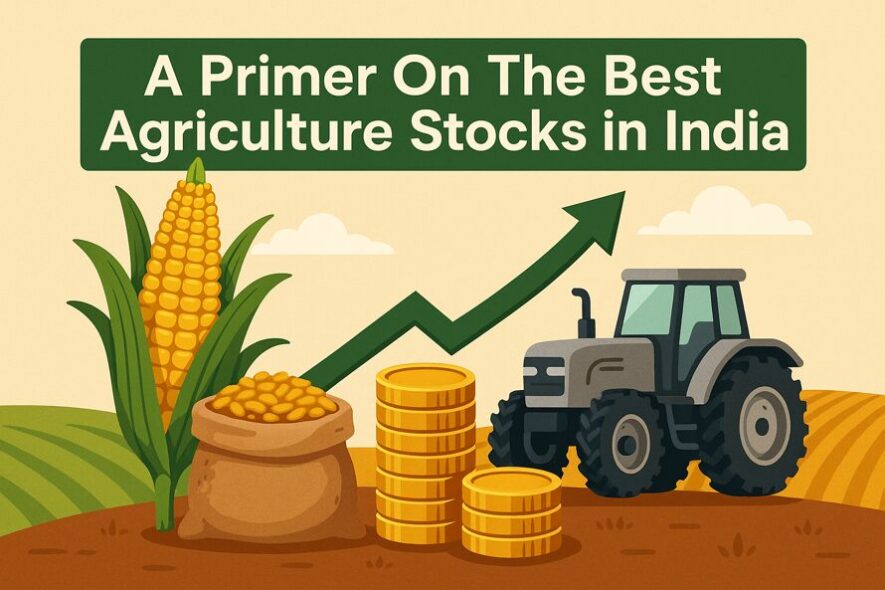
Overview of India’s Agri Sector & Investment Potential
Role in the Indian Economy
Agriculture remains the backbone of India, with millions of farmers depending on it for their livelihood. The farm sector feeds the country. It supplies raw materials for food processing, textiles, and exports. The sector creates rural employment and supports ancillary industries, fertilizers, seeds, logistics, and machinery.
Even as services and manufacturing grow, agriculture’s influence remains deep. On another note, fertilizers are integral to India’s agricultural economy. Any discussion on agriculture stocks in India will be incomplete without reference to fertilizer stocks. Let’s discuss leading stocks from these two closely related sectors.
Impact of Monsoon, Policy, and Tech
Monsoons are integral to the fortunes of the agriculture sector. When rains are timely and well-distributed, crop output rises; when monsoons play truant, yields drop, and input costs spike. Government policy, things like Minimum Support Price (MSP), subsidies for fertilizers or seeds, input import duties, impact the profitability of agriculture companies.
Technology also changes the game. Precision farming, better seed hybrids, drone spraying, bio-stimulators, and organic inputs help reduce costs, improve yield, and sometimes open premium markets. Companies that are quick to adopt tech often outpace their peers.
Why Invest in Agriculture Stocks?
Demand Drivers: Population & Food Security
India’s population keeps growing. Demand for food, nutritional products, processed food, protein (milk, meat), seeds, and crop protection keeps rising. Urbanization pushes demand for packaged & safe food. Export demand for spices, grains, and organic produce adds another layer.
Agriculture stocks ride this wave. Demand keeps increasing. Agriculture stocks offer long-term demand stability.
Government Support & Schemes (e.g. MSP, Subsidies)
Government intervention in the sector is significant: MSP ensures farmers get a guaranteed price for certain crops. Subsidies on fertilizers or seeds lower input costs. Schemes like Pradhan Mantri Kisan Samman, subsidy programmes for micro-irrigation, organic farming incentives, or support for agri-export zones drive growth.
These policies help reduce downside for producers and input companies. For investors, that means reduced risk if policy remains supportive.
Diversification Advantage & Defensive Play
Agriculture is less correlated with urban consumption or tech cycles. Even in economic downturns, people still need food, seeds, and fertilizers. It provides a defensive cushion. Agriculture stocks help diversify your portfolio. If your portfolio includes tech, pharma, and consumption, adding agri stocks allows exposure to a different risk-return profile.
Key Metrics for Selecting Agri Stocks
Revenue Growth & Profit Margins
Check year-on-year revenue growth. Look for margin trends, gross, operating, and net. High input cost inflation (fertilizers, energy, fuel) can squeeze margins. Companies that pass on cost, that have value-added products (special fertilisers, crop protection, speciality seeds) can sustain better margins.
Debt Levels & Working Capital Trends
Many agri businesses carry working capital-heavy inventory, receivables, and seasonal cycles. If debt is high, interest burdens bite. Also, watch receivable days and whether the company can manage cash flow in lean seasons. Good companies manage debt prudently, keep a buffer for seasons and monsoon shocks.
Product Diversification (seeds, fertilisers, food processing)
Companies that produce multiple things, fertilizers + seeds + crop protection + maybe even food products, spread risk. If fertilizer demand falls, seed demand or bio-stimulants may rise. Specialty or niche products (micronutrients, organic inputs) often command a premium. Diversification helps reduce dependence on a single input or policy sector.
R&D, Sustainability & ESG Practices
R&D: For seed companies, for crop protection, for organic/bio inputs, for climate-resilient crops. Companies investing in innovation often get ahead. Sustainability: water usage, soil health, and ESG practices matter increasingly for regulators and premium markets. Investors prefer companies with sustainable inputs, less environmental damage, and good labor practices.
Leading Agriculture Stocks in India by Market Cap
Here are some leading agriculture stocks, drawn from Lemonn and categorized by size and focus. These are well-known names showing up repeatedly in “top agri stocks” charts.
Large-Cap Agribusinesses
- Coromandel International Ltd: Fertilizer + crop protection + speciality nutrients. Strong distribution in South and East India.
- UPL Ltd: Global reach in agrochemicals, a strong export and pesticide business.
- PI Industries Ltd: Seeds and custom agrochemical synthesis, R&D focused, good product mix.
Mid-Cap Growth Leaders
- Sumitomo Chemical India Ltd: Focuses on crop protection, with some international technology tie-ups.
- Bayer CropScience Ltd: Known for both seeds and chemicals, it has good margin potential with branded products.
- Godrej Agrovet Ltd: Animal feed + integrated agribusiness, good presence in food processing and sustainability segments.
Specialty/Niche Plays (organics, biotech, precision farming)
- Kaveri Seed Company Ltd: Strong seed R&D, hybrid seeds, vegetable & cash crop seeds.
- Bombay Burmah Trading Corp, A plantation (tea, coffee) business, gives plantation commodity exposure.
- Nath Bio-Genes: Biotech/seeds/bio-stimulators specialist, non-GMO & hybrid seed play.
Comparative Analysis: Large-Cap vs. Mid-Cap Agri Stocks
Risk–Return Dynamics
Large-cap agribusinesses typically offer steadier returns with less risk. They may grow slower, but with more predictability. Mid-caps & niche ones tend to give high returns in good years but tend to suffer steeper falls in bad times (monsoon failures, policy shifts). The asymmetry between reward and risk is larger with mid-cap plays.
Volatility, Liquidity & Long-Term Outlook
Large-caps tend to be more liquid, with easier entry and exit, and tighter bid-ask spreads. Mid & niche stocks may get thin volumes or sharp intraday movement. For long investment horizons (5-10 years), mid-caps can outperform, provided the investor can stomach volatility. For shorter horizons, large-caps give cushion.
Investment Time Horizon
If you plan for 5+ years, include a mix: large caps for stability and mid/niche for growth. For a 2-3 year horizon, large-caps are safer bets. If you need money sooner, minimize exposure to volatile seeds or chemical stocks that depend strongly on weather or input costs.
Impact of Global Trends & Domestic Policy on Agri Stocks
Climate Change & Weather Risks
Erratic rain, unseasonal droughts, and floods directly impact yield. Input costs rise. Crop failures lead to less demand for downstream products. Thus, agrochemical and fertilizer companies may see a drop in off-take. Companies investing in climate-resilient seeds or water-efficient solutions are likely to do better.
Export Markets & Commodity Prices
Global commodity cycles (fertilizer raw materials, agrochemical ingredients) impact the cost base. Export demand, trade agreements, and currency fluctuations matter. If the rupee weakens, exporters gain. If import duties on inputs rise, margins are squeezed. Also, global food prices affect domestic farm earnings and government policy (MSP, subsidies).
Recent Government Reforms (e.g., agri-export zones)
The government of India has launched several reforms, including agri-export promotion, improved cold storage infrastructure, policy support for organic farming, subsidies for bio-inputs, and schemes for vegetable & fruit processing. These reforms reduce wastage, improve market access, and improve margins. Companies that align with reforms may have an advantage.
How to Invest in Agriculture Stocks
Direct Stock Picking vs Themed ETFs/Mutual Funds
If you understand stocks, financials, and risks involved, direct investing can reward you handsomely. Themed ETFs or mutual funds focused on agriculture or agribusiness spread risk across many players. If any one company falters, the rest may balance. Use direct stocks for core picks; use funds for ancillary exposure.
SIPs in Agri Funds
If funds exist for the agriculture sector, SIPs help smooth out entry. Buying small across seasons enables you to avoid buying at peak fertilizer or input inflation. SIP reduces the risk of timing.
Portfolio Allocation for Rural & Agri Exposure
Don’t overweight agriculture in your portfolio. You could allocate 5-15% of the equity portfolio to agriculture depending on risk appetite. Within that, diversify: fertilizer/seed/agrochemical/food processing. Monitor regulatory, weather, and input cost risk frequently.
Risks to Watch in Agriculture Investing
Regulatory Headwinds & MSP Revisions
MSP revisions (increases or delays), subsidies removal or changes, import/export restrictions can dramatically impact profitability. Also, bans on some agrochemical ingredients and environmental regulations can squeeze margins.
Input Cost Inflation (fertilisers, seeds, energy)
Fertilizers, raw chemical inputs, energy (fuel, power), and labor costs matter. If these costs rise faster than product prices, margins shrink. Many companies struggle to pass cost increases to farmers, especially when government caps or pricing controls exist.
Climate and Crop Yield Volatility
Weather risk is real. Droughts, floods, pest attacks, and poor rainfall ruin crop yields. That ripple impacts seed demand, fertilizer demand, and the whole supply chain. Companies with good R&D/resilient operations/large geographies are better placed, but risks remain.
Conclusion
Agriculture stocks offer a blend of growth and defensive qualities. The best picks exhibit strong revenue trends, margin discipline, product diversity, robust R&D, and a sustainability orientation. Large-cap agri names like Coromandel International, UPL, PI Industries, and Bayer CropScience offer stability and scale. Mid & niche firms like Kaveri Seeds, Godrej Agrovet, Nath Bio-Genes provide growth potential and specialized innovation.
For investors: combine exposure across large + mid + specialty, watch policy changes, input costs, and weather signals. Be patient across monsoon cycles. If you build an agri exposure thoughtfully, it can boost returns while cushioning portfolio volatility.
FAQs:
Q. Which are India’s top agriculture stocks by market cap?
Some of the largest agriculture/agribusiness stocks by market cap include Coromandel International, PI Industries, UPL, Sumitomo Chemical India, and Bayer CropScience.
Q. Are agribusiness stock returns seasonal?
Yes, returns often show seasonal patterns. Cropping cycles, monsoons, harvest periods, and input demand spikes make demand and profits vary over the year. Input cost inflation just before monsoon or harvest events also plays a role.
Q. Can precision farming startups be good investment plays?
They can be. Startups focusing on precision farming, bio-inputs, drone-based spraying, and seed tech can offer high growth if they scale well. But they also carry high execution risk and may take time to deliver profitability.
Q. How do weather risks affect stock prices?
Weather risk (poor rains, droughts, floods) impacts crop yields and farmer incomes. That reduces demand for fertilizers, agro-chemicals, and seeds, and also influences the cost of raw materials. Stocks tied to farming inputs often move sharply in response to the weather outlook. When the monsoon forecast is weak, agri stocks tend to dip.
Q. Is it better to invest via ETFs or direct agri equities?
Both have pros. Direct equities offer higher reward & control (you pick individual companies). ETFs or sector funds reduce company-specific risk and provide diversification. If you don’t have time or expertise, ETFs or mutual funds are safer. If you follow the sector closely, a mix of both works well.
Q. Do agriculture stocks pay good dividends?
Some do. Large-cap agri/fertilizer/agrochemical companies often have stable cash flows and offer moderate to good dividend yields. However, dividend payouts vary across companies depending on their profit, debt, and capital expenditure needs. You’ll see yield differences: some agri stocks yield better than others.




